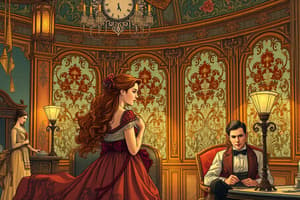Podcast
Questions and Answers
What does a story's setting provide for characters and events?
What does a story's setting provide for characters and events?
- Dialogue and conflict resolution
- Cover illustration and page count
- Context and atmosphere (correct)
- Character names and plot twists
How does the time period contribute to a story's appeal?
How does the time period contribute to a story's appeal?
- By designing the book cover
- By choosing the font style
- By selecting the chapter titles
- By creating a framework for the narrative (correct)
What is one potential outcome of setting a story in a dystopian future?
What is one potential outcome of setting a story in a dystopian future?
- Exploring current issues from a different perspective (correct)
- Discussing ancient mythology
- Analyzing romantic comedies
- Focusing on historical battles
How does the location of a story influence its tone and themes?
How does the location of a story influence its tone and themes?
What does the location of a story refer to?
What does the location of a story refer to?
How do authors use the time period to help readers navigate a story?
How do authors use the time period to help readers navigate a story?
Flashcards are hidden until you start studying
Study Notes
Story Setting
A story's setting is one of its most crucial elements, providing context and atmosphere for characters and events. It includes information about when and where the action takes place. The two primary aspects of a story's setting are the time period and the location. Each element contributes significantly to a story's appeal and understanding.
Time Period
The time period refers to the specific era or historical context within which a story unfolds. This can range from ancient civilizations like Egypt or Greece to modern times. By specifying a particular time frame, authors create a framework for their narrative, helping readers navigate the story and understand how characters interact with various social and cultural factors.
For instance, a story set during the Victorian era might focus on societal norms related to class and marriage, while a story set in the 1960s could explore themes of social change and counterculture. Similarly, a story set in a dystopian future might use sci-fi elements to explore current issues from a different perspective.
Location
The location is another vital component of a story's setting, referring to the geographical area where the story takes place. This could be a real-world location like New York City or a fictional one like Hogwarts in the Harry Potter series.
The location can greatly influence the story's tone and themes. For example, a story set in a dense urban city might emphasize themes of isolation or loneliness, while a story set in a rural town might focus on community and cooperation. The location can also provide unique challenges and situations for characters, adding depth to the narrative.
In conclusion, the time period and location in a story's setting are essential elements that inform readers about the context and provide a foundation for the narrative. By carefully considering these aspects, authors can create immersive worlds that engage readers and enhance the story's overall impact.
Studying That Suits You
Use AI to generate personalized quizzes and flashcards to suit your learning preferences.




